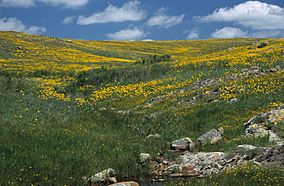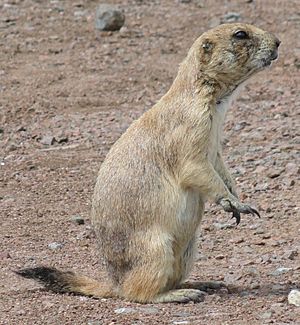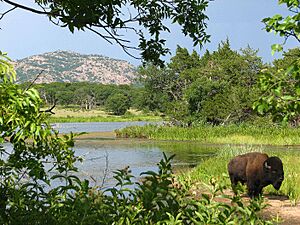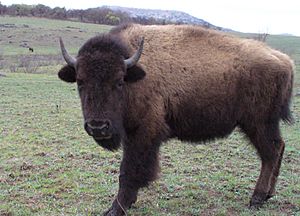Wichita Mountains Wildlife Refuge facts for kids
Quick facts for kids Wichita Mountains Wildlife Refuge |
|
|---|---|
|
IUCN Category IV (Habitat/Species Management Area)
|
|

Spring wildflowers in the refuge
|
|
| Location | Comanche County, Oklahoma, United States |
| Nearest city | Meers |
| Area | 59,020 acres (238.8 km2) |
| Established | 1901 |
| Governing body | United States Fish and Wildlife Service |
| Website | Wichita Mountains Wildlife Refuge |
The Wichita Mountains Wildlife Refuge is a special place in southwestern Oklahoma, close to the city of Lawton. It has protected unique wildlife and their homes since 1901. This makes it the oldest managed wildlife area in the United States Fish and Wildlife Service system.
The refuge is located in the amazing Wichita Mountains, which are about 500 million years old! It also has untouched areas of mixed grass prairie. These features make it a very important place for nature. The refuge covers about 59,020 acres (238.8 km²). It is home to many different kinds of living things. You can find 806 plant species, 240 types of birds, 36 kinds of fish, and 64 species of reptiles and amphibians here.
Contents
History of the Refuge
The Wichita Forest Reserve was created in Oklahoma on July 4, 1901. It started with about 57,120 acres (231.1 km²). This happened under the United States General Land Office.
Later, in 1905, federal forests were moved to the U.S. Forest Service. So, on March 4, 1907, it became the Wichita National Forest.
On June 4, 1936, the name changed again. The Wichita Forest was officially ended. Its management was given to the Bureau of Biological Survey. This group later became the Fish and Wildlife Service. At that time, it was renamed the Wichita Mountains Wildlife Refuge (WMWR).
What is the Refuge Like?
The U.S. Fish and Wildlife Service manages the Wichita Mountains Wildlife Refuge. This group works to protect wildlife and their habitats. Inside the refuge, there are 13 small lakes. These lakes provide water and homes for many animals.
Animals of the Refuge
The U.S. Fish & Wildlife Service has recorded many different animals here. There are 240 types of birds, 50 kinds of mammals, 64 species of reptiles and amphibians, and 36 types of fish.
Large Mammals and Their Return
Several large native mammals live in the refuge. These include plains bison, also called American bison. You can also see elk and white-tailed deer. These animals eat grass on the prairies. Texas longhorn cattle are also here. They are kept for their cultural and historical importance.
Bison, longhorns, and elk were brought back to the refuge after it was created. The original type of elk in this area, called Merriam's elk, is now extinct. So, the elk in the refuge are Rocky Mountain elk. Their ancestors came from Jackson Hole, Wyoming in 1911. The elk herd is the largest in Oklahoma, with about 1,000 animals. There are also about 450 white-tailed deer. These large, hoofed animals are no longer considered endangered.
Smaller Animals and Reintroductions
Many smaller mammals also live in the refuge. These include the nine-banded armadillo, the bassarisk, and the black-tailed prairie dog. Other animals that have been brought back to the refuge include the river otter and burrowing owls. Even though these species were not endangered, the Fish and Wildlife Service wants to make sure that animals that once lived here can always be found in these mountains. Some attempts to bring back animals did not work. For example, the American pronghorn antelope, bighorn sheep, and prairie chicken did not successfully return.
Saving the Bison
The refuge has played a very important part in saving the American buffalo from disappearing. In 1907, the American Bison Society brought 15 bison to the refuge. There were six male bison (bulls) and nine female bison (cows). They came from the Bronx Zoo. When they arrived, the Comanche leader Quanah Parker and many others welcomed them. At that time, bison had not been seen on the southern Great Plains for 30 years.
Today, the bison herd in the refuge has about 650 animals. In the past, extra bison were sold in an auction. This helped manage the herd size. However, this practice stopped in 2020. The refuge joined the Bison Conservation Initiative. This initiative has five main goals: healthy wild bison herds, protecting their genes, sharing care, restoring their natural homes, and bringing back their cultural importance. It also helps send bison from federal herds to Native American tribes. For example, in 1973, the refuge gave three bison to the Fort Worth Nature Center and Refuge to help their conservation efforts.
Bird Life
The refuge is home to many kinds of birds. It is one of the last places where the black-capped vireo lives. This bird was recently removed from the endangered species list.
Plants of the Refuge
The refuge has many different types of plant life. You can find prairie, ravine, and mountain plant communities. Many exposed granite boulders are covered in a bright, chartreuse green lichen called "Pleopsidium flavum."
Some parts of the refuge have scrubby forests with different kinds of oak trees. A special group of bigtooth maple trees also grows here. These trees are about 400 miles (644 km) from the nearest natural group in West Texas. This means they are a "disjunct population," growing far from where they usually are found.
Fun Things to Do
There is no charge to enter the refuge. About 22,400 acres (90.6 km²) are open for public use. The other 37,000 acres (150 km²) are protected wildlife habitat. There is a visitor center and a bookstore. They have art and exhibits that show the four main habitats in the refuge: Rocklands, Aquatic, Mixed-Grass Prairie, and Cross Timbers.
The refuge is a popular spot for many outdoor activities. Rock climbing is very popular here. Visitors also enjoy hiking, camping, fishing, watching birds and other wildlife, and taking photos. The refuge has many trails, including about 15 miles (24 km) of official trails.
Rock Climbing Adventures
The area became popular for rock climbing in the 1960s and 1970s. It is now a well-known climbing spot in the region. Climbing brings many visitors, but there has been some discussion about using fixed anchors and bolts on the rock faces. The refuge works with groups like The Access Fund to encourage responsible climbing. Rock climbing routes are found on Mount Scott, which is the refuge's second-highest peak. You can also climb in areas like the Narrows and the Charon Gardens Wilderness Area.
Fishing and Hunting
Fishing is popular in the 13 artificial lakes in the refuge. You can catch largemouth bass, sunfish, crappie, and channel catfish. Elk and deer hunting is allowed in a managed hunt each fall. This helps control the number of animals. Hunters are chosen by a lottery, and there is a fee.
Scenic Views
A narrow, winding road leads to the top of Mount Scott. It is 2,464 feet (751 meters) high. From the top, you can see the entire refuge. The mountains are steep and rocky, even though they only rise about 800 to 1000 feet (244 to 305 meters) above the surrounding prairie. The highest mountain in the refuge is Mount Pinchot, which is 2,479 feet (756 meters) tall. It was named after Gifford Pinchot, who was the first chief of the United States Forest Service.
Images for kids









